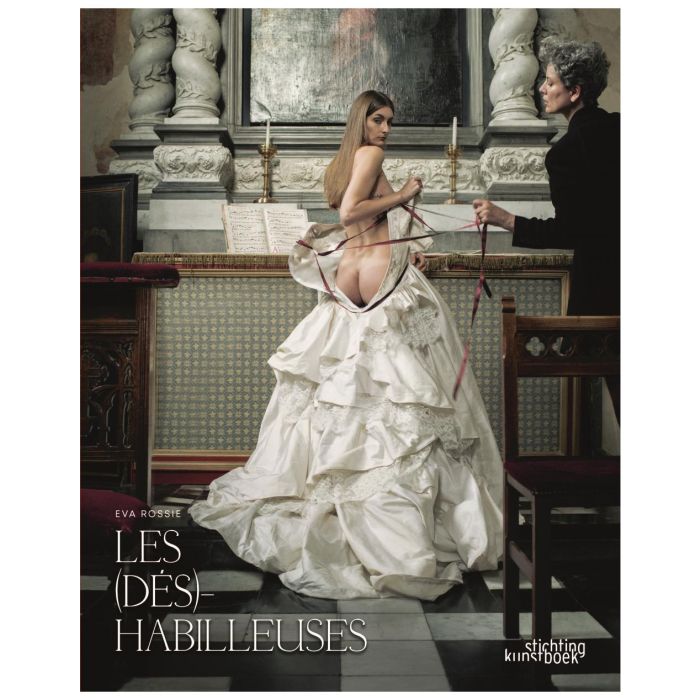My Cart
Your cart is empty
Looks like you haven't made your choice yet.
- Subtotal
Les (Dés)Habilleuses

Eva Rossie
- Stichting Kunstboek
- Expo: 18/02/2023 - 26/03/2023, Kasteel van Laarne
More Information
| Publisher | Stichting Kunstboek |
|---|---|
| ISBN | 9789058567055 |
| Publication date | February 2023 |
| Edition | Paperback with flaps |
| Dimensions | 300 x 240 mm |
| Pages | 112 |
| Language(s) | Eng/ NL ed. |
| Exhibition | Kasteel van Laarne |
Description
Voor Les (Dés)Habilleuses, liet fotografe Eva Rossie zich inspireren door genderrollen en het Kasteel van Laarne. Kamer per kamer worden de vroegere bewoners van het kasteel visueel onderzocht door haar eigen lens. Daarbij fungeert de kleedster als spilfifiguur: de panoptische bewakingscamera avant la lettre die tegelijk in een kwetsbare positie zat. Er wordt gespeeld met het contrast tussen zij die bedekken en blootgeven, zij die alles zien en horen, zij die klein gehouden worden en zij die vriendelijk bedanken voor de ketenen van het keurslijf. Rossies personages ondersteunen een hedendaagse kijk op de invulling van gender, zonder de geschiedenis uit het oog te verliezen. Want het is net deze geschiedenis die dienst doet als uitgangspunt om op zoek te gaan naar een alternatieve, hedendaagse blik op wat mensen mogen en kunnen zijn. Het resultaat zijn gelaagde foto's die aandoen als fifilmstills met een kwetsbaar randje.
For Les (Dés)Habilleuses, photographer Eva Rossie was inspired by gender roles and Laarne Castle. The former inhabitants of the castle are visually explored, room by room, through her own lens of the female gaze. The dresser is the main character. Because of her rather intimate position, she used to hear and see everything.
There lies a contradiction within the dresser; she was like a panoptic security camera, but she found herself in a vulnerable position at the same time. Rossie plays with the disparity between those who cover and reveal, those who see and hear everything, those who are kept small, and those who refuse the confifinement of their shackles. Rossie's characters invite a contemporary view on gender, without losing sight of history, since it is precisely what has been that serves as a starting point in the search for an alternative, contemporary view of what people can be. Presented to you are layered pictures like fifilm stills with a vulnerable edge.
For Les (Dés)Habilleuses, photographer Eva Rossie was inspired by gender roles and Laarne Castle. The former inhabitants of the castle are visually explored, room by room, through her own lens of the female gaze. The dresser is the main character. Because of her rather intimate position, she used to hear and see everything.
There lies a contradiction within the dresser; she was like a panoptic security camera, but she found herself in a vulnerable position at the same time. Rossie plays with the disparity between those who cover and reveal, those who see and hear everything, those who are kept small, and those who refuse the confifinement of their shackles. Rossie's characters invite a contemporary view on gender, without losing sight of history, since it is precisely what has been that serves as a starting point in the search for an alternative, contemporary view of what people can be. Presented to you are layered pictures like fifilm stills with a vulnerable edge.
For Les (Dés)Habilleuses, photographer Eva Rossie was inspired by gender roles and Laarne Castle. The former inhabitants of the castle are visually explored, room by room, through her own lens of the female gaze. The dresser is the main character. Because of her rather intimate position, she used to hear and see everything.
There lies a contradiction within the dresser; she was like a panoptic security camera, but she found herself in a vulnerable position at the same time. Rossie plays with the disparity between those who cover and reveal, those who see and hear everything, those who are kept small, and those who refuse the confifinement of their shackles. Rossie's characters invite a contemporary view on gender, without losing sight of history, since it is precisely what has been that serves as a starting point in the search for an alternative, contemporary view of what people can be. Presented to you are layered pictures like fifilm stills with a vulnerable edge.

Les (Dés)Habilleuses
